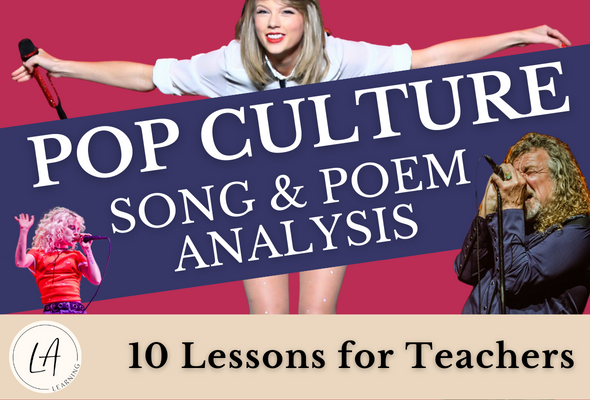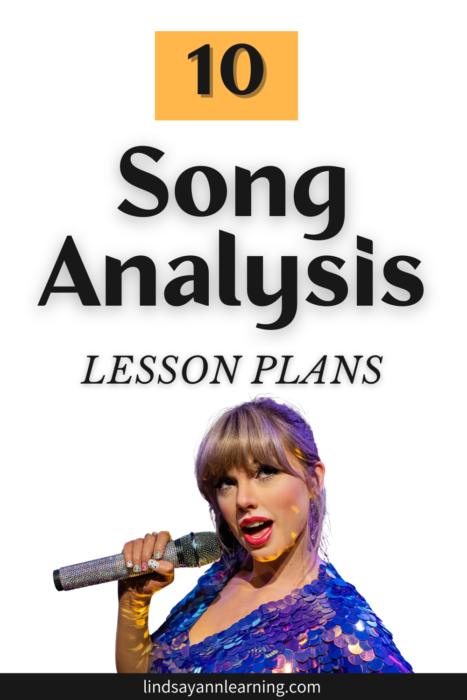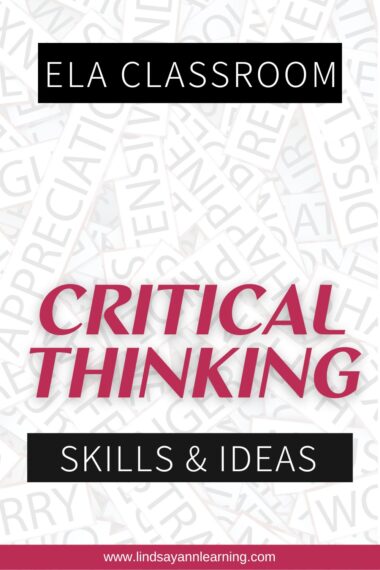One of the positive shifts that happened as a result of PARCC becoming a short-lived focus in my district and state was that attention shifted to paired text analysis of shorter texts. Even as Illinois shifted to IAR and parted ways with yet another educational acronym, the idea of quick-hit analysis with short texts stuck with me. I will always keep song analysis and poem analysis with paired texts as a part of my classroom routine thanks to PARCC.
Why?
It is easy to scaffold and differentiate song analysis lessons. I can integrate poems as mentor texts, as well. But the BIGGEST benefit is that these short texts engage students and build a foundation for the analysis of longer novels such as Their Eyes Were Watching God or Great Expectations.

Song Analysis & Poem Analysis: Building a Foundation
I begin the year with a review of essential reading, writing, and close reading skills.
We spend time breaking down and discussing various poems such as “Nikki Rosa“, “Tattoo“, and “Ode to my Socks.” I play songs for them and we unpack the meaning behind the lyrics. Songs like “Dig” and “Anti-Hero” and “Hotel California.”
As we engage in poem analysis and song analysis, we talk about word choice, connotations, pattern-hunting, and review common poetic and literary devices organically as they come up in our texts.

Then, we practice analyzing the songs and poems to prove a claim. It’s one step forward to notice an important word or a connotation, but it’s a higher-level skill to unpack and explain how the author’s choices are designed to convey a message.
And it’s even more complex to put it all down in writing: thesis statements and topic sentences, using evidence to prove a claim, paragraph structure, and idea development.
All of this happens in cycles, with a lot of modeling and discussion – we go slow to go fast.
After students are comfortable analyzing a single text, I pair multiple texts for a larger conversation, asking students analyze these texts as cultural critics and to apply literary lenses.
Students discuss and synthesize texts and ideas as they bring different texts into conversation with each other as we explore an essential question such as:
- What is the meaning of “love” in society?
- What can “Anti-Hero” by Taylor Swift teach us about the Hero’s Journey?
- How can the songs “Cry Pretty” and “Growing Up” guide a discussion about gender roles and norms?

Skill Integration
The skills that students review and expand upon in the poem and song analysis learning cycles will serve them well throughout the school year.
As we read short stories and novels, the text complexity increases, and we fold in character and plot discussions, but the foundation for in-depth and analytical thinking is there.

Plus, it’s a lot easier for students to reflect and revise (and a lot easier for me to provide formative feedback) when the stakes are lower and the texts and analysis writing are short and focused.
That’s how my students find themselves writing 12-15 page literary analysis papers during second semester. For this assignment, they engage in college-level analysis, critiquing a literary critic’s perspective on a novel and using their own thinking and evidence from the text to prove and disprove that critic’s claims.
Yet… students, once the lightbulb goes on that this is simply a rinse and repeat of poem and song analysis to build an overall argument, they find that they can do it. I hear comments that “I just had so much to say” and that “it was easier than I expected.”
All thanks to a solid foundation that we add to throughout the year.
Song Analysis Lesson Plans
Because song analysis and poem analysis is a passion of mine, I decided to create pop-culture paired text song and poem analysis lessons to share with other English teachers.

Build a strong foundation for full-length novel study or use these lessons as a part of your novel or short story unit.
Make close reading, textual analysis and literary analysis less intimidating with 10 lesson sequences…that’s 31 CCSS-aligned song analysis and poetry analysis lesson plans for paired texts. Integrated close reading, text-based writing, speaking, research, and inquiry skills, make these pop culture lessons both engaging and worthwhile.
When you purchase the product bundle, you’ll receive 10 Detailed, CCSS-Aligned Lesson Plan Sequences (That’s 31 total lesson plans!) and Teacher Notes (41 Pages) that each provide an opener, writer’s notebook activity, poem + song analysis, and writing activity options.
But because I love you and would never leave you hanging…these lesson plans come with digital and print versions of all of the handouts and activities you need. Digital & Print Lesson Handouts (238 Pages/Slides) correspond with lesson plan activities and are designed to help students practice core skills as they engage with the texts.
10 Song Analysis Lesson Packs
Click HERE to grab all 10 lesson packs at a 30% discount!
- Carrie Underwood’s song “Cry Pretty” & Macklemore & Ryan Lewis’ song “Growing Up”
- William Ernest Henley’s poem “Invictus” & Imagine Dragons’ song “Whatever it Takes”
- Maya Angelou’s poem “Still I Rise” and Tupac’s song “Still I Rise”
- Stephen Dobyns’ poem “Loud Music” and Incubus’ song “Dig”
- “Anti-Hero” by Taylor Swift
- “Boulevard of Broken Dreams” by Green Day and “Brick by Boring Brick” by Paramore
- “Hotel California” by the Eagles and “Stairway to Heaven” by Led Zeppelin
- Protest Songs
- Love Songs
- “Mad World” by Tears for Fears and “A Million Dreams” sung by Pink / The Greatest Showman


















 10 Tips for Making the Most of Blended Learning
10 Tips for Making the Most of Blended Learning